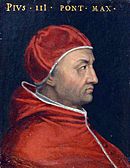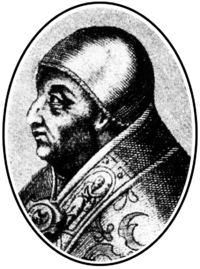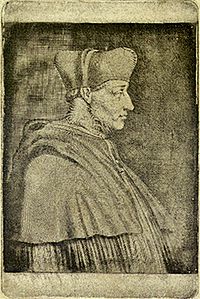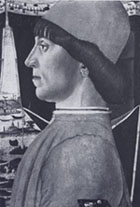September 1503 papal conclave facts for kids
Quick facts for kids Papal conclaveSeptember 1503 |
|
|---|---|
| Dates and location | |
| September 1503 Apostolic Palace, Papal States |
|
| Key officials | |
| Dean | Giuliano della Rovere |
| Camerlengo | Raffaele Riario |
| Protodeacon | Francesco Todeschini-Piccolomini |
| Election | |
| Candidates | Georges d'Amboise, Giuliano della Rovere, Francesco Todeschini Piccolomini |
| Ballots | 2 |
| Elected pope | |
| Francesco Todeschini Piccolomini Name taken: Pius III |
|
 |
|
A papal conclave is a meeting where cardinals of the Catholic Church gather to elect a new Pope. The September 1503 papal conclave was held to choose a new Pope after Pope Alexander VI passed away. This was a very important election because it happened during a time of war in Italy, known as the Italian Wars.
During this conclave, the group of cardinals, called the College of Cardinals, was surrounded by three different armies. These armies belonged to Louis XII of France, Ferdinand II of Aragon, and Cesare Borgia. Cesare Borgia was Pope Alexander VI's son and a powerful military leader.
Thirty-nine cardinals took part in this election, making it the largest conclave ever at that time. There were 21 Italian cardinals, 11 Spanish cardinals, and 7 French cardinals. Many people expected Georges d'Amboise, a French cardinal, to be elected. However, things did not go as planned. On the first vote, he got fewer votes than expected. This was partly because Giuliano della Rovere (who would later become Pope Julius II) ran against him, and Cesare Borgia lost control over the Spanish cardinals. In the end, d'Amboise decided to support Cardinal Francesco Piccolomini. Piccolomini was then elected Pope on the second vote, even though he only had four votes on the first. He chose the name Pope Pius III.
| Top - 0-9 A B C D E F G H I J K L M N O P Q R S T U V W X Y Z |
What Was Happening in Italy?
The election of the new Pope happened during a period called the Italian Wars. These wars began when Charles VIII of France tried to claim the Kingdom of Naples in Southern Italy. He wanted to take it from Ferrante of Aragon. Ferrante was helped by his relative, Ferdinand II of Aragon, who was the King of Spain.
Pope Alexander VI first supported Ferdinand of Aragon. But in 1498, he changed his mind and recognized Louis XII of France as the rightful king of Naples. Louis XII was the heir to Charles VIII. However, Ferdinand's army was doing well in the war. So, Louis XII sent more soldiers to Italy in 1503. These French soldiers were near Rome when Pope Alexander VI died in August. Instead of going straight to Naples, Louis XII ordered his army to wait outside Rome until the new Pope was elected. Another army from Naples was also only about 40 miles south of Rome.
Cesare Borgia, who was a former cardinal and the Pope's military commander, also had his army inside Rome. But Cesare became very sick, which weakened his power. Because of the threat from these three armies, the cardinals first thought about meeting in Castel Sant'Angelo, a strong fortress. The start of the conclave was delayed because they needed to get the building ready. They also needed Cesare to agree to move his troops out of the city. However, on September 3, the cardinals decided to meet in a chapel inside the Apostolic Palace instead.
Who Were the Cardinals?
There were thirty-nine cardinals who could vote in this election.
Georges d'Amboise was the favorite candidate of Louis XII, the King of France. He also expected support from Cardinal Giuliano della Rovere. Della Rovere had been in France because he had a disagreement with the previous Pope, Alexander VI. For years, the French kings had been working to help d'Amboise become Pope. They even made a secret agreement with Cesare Borgia. In exchange for Cesare's support from the Spanish cardinals (who were more loyal to Cesare than to the King of Spain), Cesare would keep his lands. Also, Ascanio Sforza, an Italian cardinal who had been captured by the French, was set free. He promised to vote for d'Amboise in return.
D'Amboise also had a lot of money to spend. People said that no amount of bribery or threats was spared to help him win. When he arrived in Rome on September 10, the crowds cheered for him, believing he would be the next Pope.
A French messenger told the cardinals that the King would be very upset if the conclave started before d'Amboise and the other French cardinals arrived. Della Rovere also sent a message asking the cardinals to wait for him. Usually, the conclave would start ten days after the Pope's funeral. But to allow these important cardinals to arrive, the College of Cardinals decided to delay Alexander VI's funeral. The conclave finally began on September 21. D'Amboise and his supporters arrived on time. Only two of the eight missing cardinals were French.
With thirty-nine cardinals voting, this was the largest papal election since the system of the papal conclave was created.
Who Was Expected to Win?
People in Rome who bet on elections didn't think d'Amboise was a sure winner, even though the public did. They gave him odds of 13 to 100. Della Rovere's odds were 15 to 100. Cardinal Piccolomini, who was eventually elected as Pope Pius III, was actually the favorite with odds of 30 to 100.
The Election Process
The cardinals started by writing a document called a conclave capitulation. This document set out rules for the new Pope. Unlike earlier agreements, this one did not mention limiting the number of cardinals to 24. However, it did say that the new Pope would pay 2,400 ducats (a type of money) each year to any cardinal who earned less than 6,000 ducats.
The French cardinals soon realized that Della Rovere was more ambitious than they thought. He said he would only vote for d'Amboise if his vote was the very last one needed for d'Amboise to win. Della Rovere also said he wanted an Italian Pope, not a "barbarian" (meaning a non-Italian). He was worried about the Pope's power returning to Avignon, France, as it had in the past. All twenty-two Italian cardinals agreed with him. D'Amboise agreed to move the French army further north as a sign of trust, but then he understood Della Rovere's true intentions.
Ascanio Sforza kept his promise to vote for d'Amboise. However, he did not try to convince any other Italian cardinals to do the same.
Also, Cesare Borgia was too sick to control the Spanish cardinals. Instead, they followed the orders of the King of Spain, who told them to vote against the French candidate. The Spanish cardinals themselves could not be elected because the Italian cardinals were against anyone connected to the previous Pope, Alexander VI.
The Votes

Different reports from the conclave give slightly different numbers for the first vote. However, the most accurate report says that Della Rovere received 15 votes, d'Amboise received 13 votes, and Piccolomini received 4 votes. This was bad news for d'Amboise. He knew that many of his supporters had only promised to vote for him on the first try. So, d'Amboise decided to give his support to Piccolomini.
Piccolomini was elected on the second vote. He chose the name Pope Pius III in honor of his uncle, Pope Pius II. Piccolomini was sixty-four years old and too sick to even attend this vote. Since he was only a deacon (a lower rank in the church), Della Rovere ordained him as a bishop. Sadly, Pope Pius III died soon after, on October 18.
Images for kids
See also
 In Spanish: Cónclave de septiembre de 1503 para niños
In Spanish: Cónclave de septiembre de 1503 para niños






